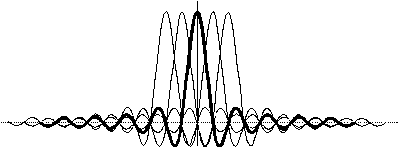
Home : Wireless LAN : PMD : OFDM : Principles
The cross correlation integral between two orthogonal sine waves, over the symbol duration Ts, is zero:
| ∫ | A1sin(2πf1t + φ1) · A2sin(2πf2t + φ2) = 0 |
| Ts |
It turns out that f1 − f2 = n · (1 / Ts), where n is an integer. The important fact about this orthogonal relationship is that a demodulator "looking at" f1 over the period Ts will be completely unaffected by f2 – without requiring an RF filter.
You can have a set of orthogonal sine waves, such that fn = f0 + n · (1 / Ts), i.e. a set of carriers at regularly spaced frequency intervals, 1 / Ts apart. A demodulator "looking at" one carrier will be unaffected by the other carriers – provided it integrates over the period Ts.
In the frequency domain (i.e. looking at the frequency spectrum), the peak of each carrier coincides with a zero point of all other orthogonal carriers.

In reality, there will some interference between the carriers, because of:
In a radio system, the transmitted signal can reach the receiver via a variety of paths, via diffraction and reflection off obstructions. The length of each path is different, so the signal reaches the receiver with variety of different delays. If the spread of delays is greater than the symbol duration, then adjacent symbols will interfere with each other.
This is the particular advantage of OFDM: because information is spread across n carriers, the symbol duration can be n times longer (compared to a single carrier system with the same data rate).
To help overcome interference, OFDM systems insert a guard time before each symbol. During the guard time, the same signal is transmitted as for the following symbol (cyclic extension), but the receiver does not "look" at the signal during the guard time.